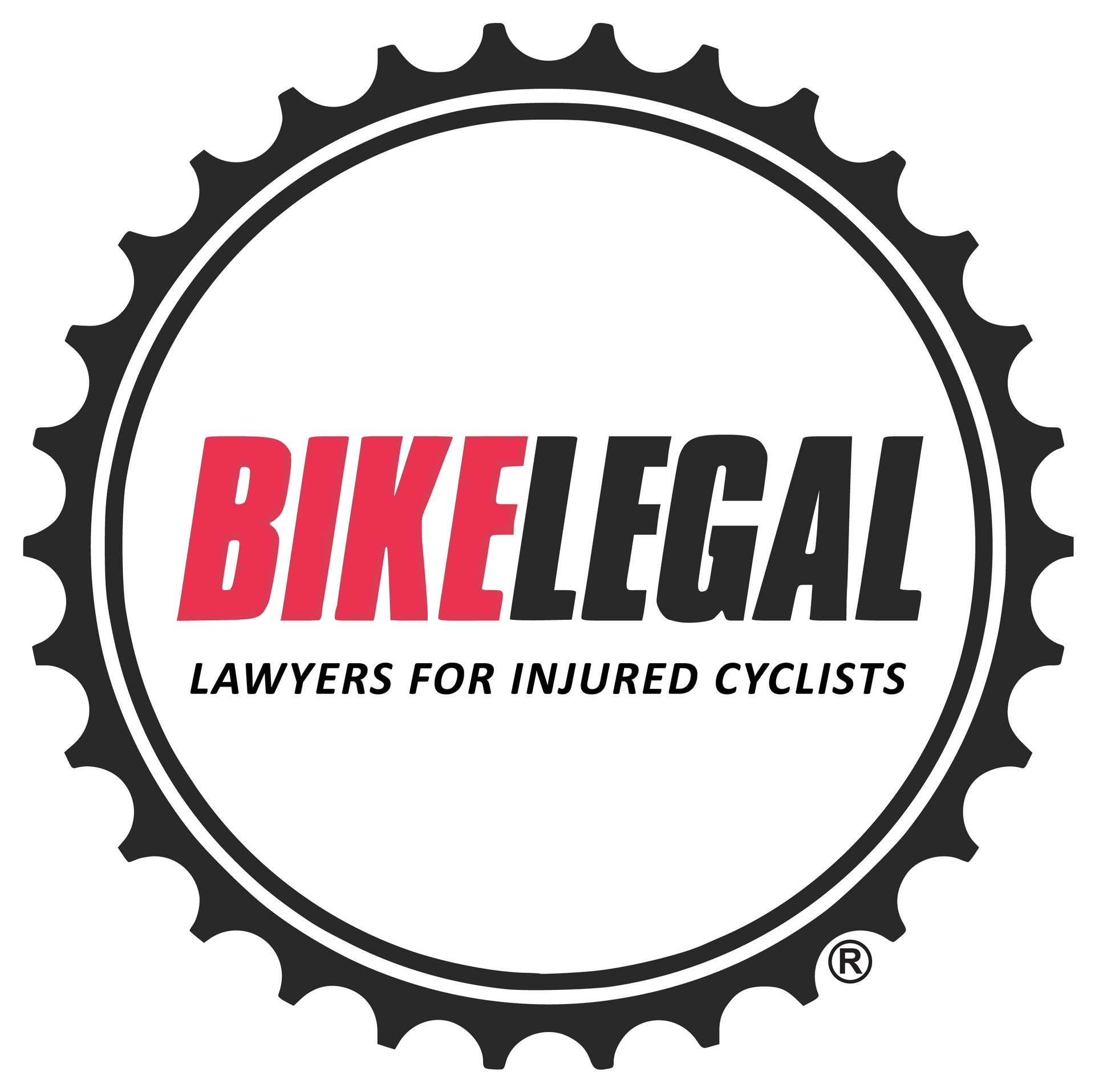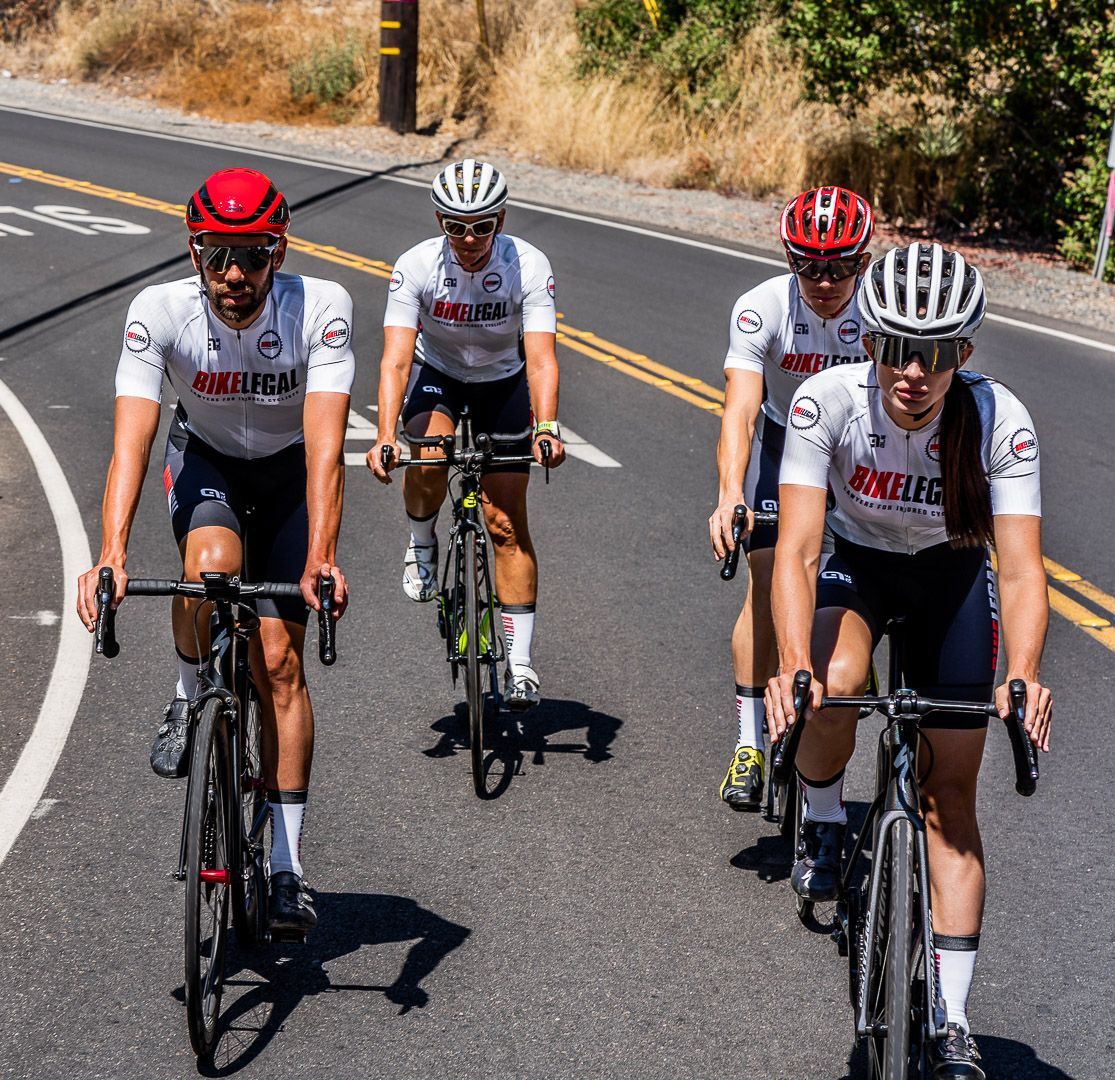Cycling Accidents with Pedestrians: Causes, Legal Rights, and Prevention
Follow us on
social media!
As more cyclists and pedestrians share streets and pathways, the risk of cycling accidents with pedestrians increases. While these incidents occur less frequently than motor vehicle crashes, they can still result in severe injuries and legal challenges for all parties involved.
Understanding the causes of cyclist-pedestrian collisions, what laws apply, and how to prevent them is crucial. With the growing use of e-bikes and shared-use paths, these accidents are becoming more common, making it essential to know your rights and responsibilities.
This guide explores cycling accidents with pedestrians, providing insight into the latest statistics, legal implications, and prevention strategies to keep everyone safe.
The Challenge of Gathering Accurate Data on Pedestrian-Cyclist Accidents in the U.S.
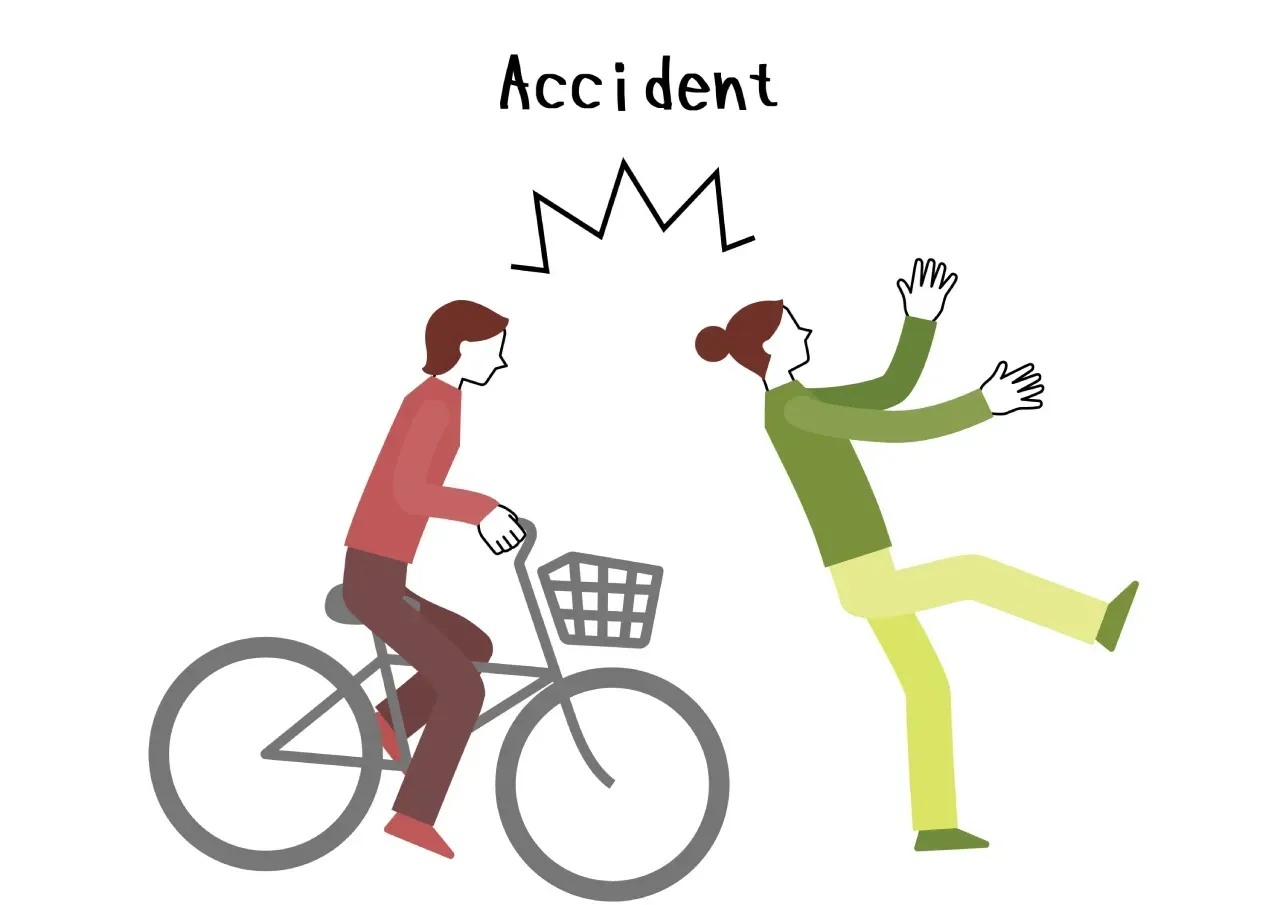
Statistics for pedestrian-cyclist accidents in the United States are difficult to pinpoint due to the lack of standardized reporting. Reporting responsibilities fall on local jurisdictions, but many of their forms do not include specific categories for accidents involving pedestrians and cyclists.
Instead, the focus is typically on crashes involving motor vehicles, as these are the most prevalent and carry the highest risk of severe injury or fatality.
To gain some insight, we used the NHTSA Crash Data and Querying Reporting Tool (FARS) to filter crashes involving pedestrians and pedal cyclists from 2019 to 2022. The tool provided the following estimated numbers for reported pedestrian injuries in cyclist-related crashes:
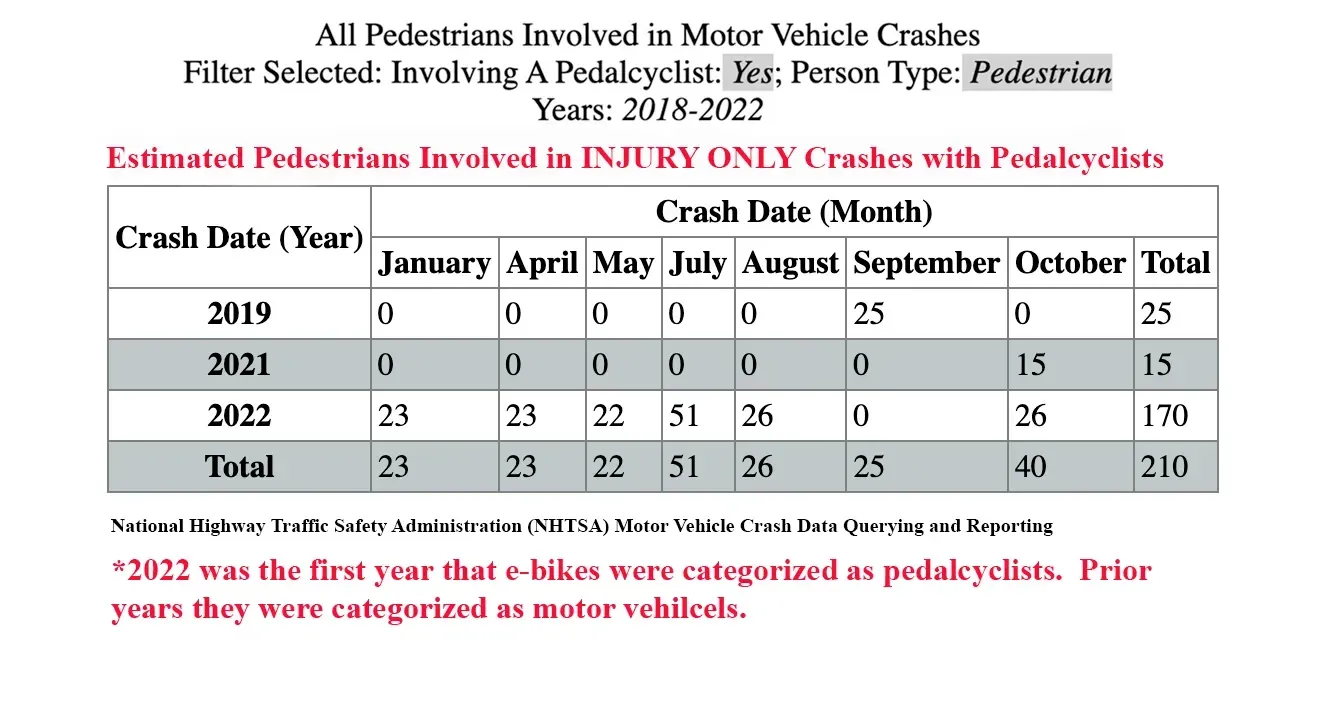
- 2019: 25 injuries
- 2020: 15 injuries (a probable decline due to reduced activity during COVID-19 lockdowns)
- 2022: 170 injuries (a significant increase, likely influenced by the inclusion of e-bikes in the "bicycle" category starting in 2022).
When it comes to fatal pedestrian crashes with pedalcyclists, the numbers were as follows:
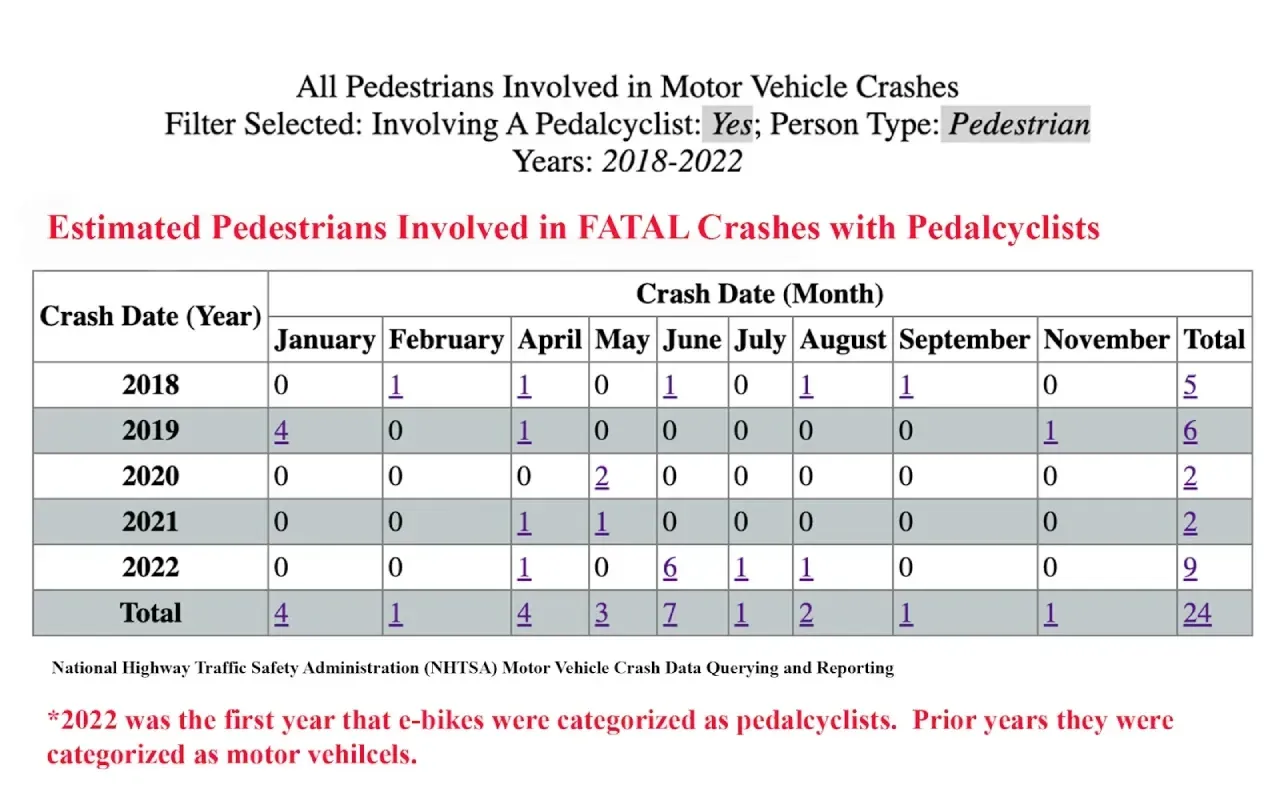
- 2019: 6 fatalities
- 2020: 2 fatalities
- 2021: 2 fatalities
- 2022: 9 fatalities
These numbers, though insightful, are merely estimates based on reports provided to NHTSA and likely represent a significant undercount. The real figures are almost certainly higher, highlighting the critical need for improved reporting practices.
The Impact of E-Bike Classification and Reporting Gaps
The year 2022 marked a notable change: According to the NHTSA 2022 Traffic Safety Facts, e-bikes were categorized as bicycles for the first time. Previously, e-bikes were considered motor vehicles, which impacted how crash data was recorded. This reclassification, along with the rising popularity of e-bikes, likely contributed to the sharp increase in pedestrian and bicyclist injuries and fatality statistics in 2022.
The current lack of detailed and standardized data underscores the need for better crash reporting protocols across all municipalities. Updated reporting forms should include all types of crashes—whether they involve motor vehicles, bicycles, pedestrians, scooters, or other modes of transportation.
E-bikes have different classifications, which affect how they are regulated and insured. Here’s everything you need to know about e-bikes, including speed limits, laws, and safety requirements.
The Importance of Better Reporting and Infrastructure Improvements
Accurate and comprehensive data is crucial for identifying trends, understanding risks, and addressing the causes of pedestrian and bicyclist fatalities. With better reporting systems in place, local and federal agencies can make informed decisions about where and how to invest in infrastructure improvements to protect all road users.
The rise of e-bikes and other shared-use mobility options further underscores the importance of tracking crashes involving all types of vehicles and pedestrians. By including these in updated reporting forms, municipalities can gain a clearer picture of the challenges on their streets, ultimately paving the way for safer, more inclusive infrastructure.
Cycling Accidents with pedestrians in NYC and Washington, DC
- New York City: In 2022, there were 3 pedestrian fatalities and 313 injuries caused by cyclists, as compared to 131 fatalities and 13,190 injuries caused by motor vehicles.
- Washington, DC: Between 2012 and 2018, cyclist-pedestrian crashes in Washington, DC resulted in 40 minor injuries, 7 major injuries, and 1 fatality.
- Trends by age:
- Decrease in injuries among children: This trend is attributed to increasingly sedentary lifestyles, with fewer children engaging in outdoor activities like cycling or walking to school.
- Increase in injuries among pedestrians aged 45 and older: This demographic shift reflects an aging population more vulnerable to severe outcomes in collisions.
- The role of E-bikes: E-bikes, capable of reaching speeds up to 28 mph (or greater), contribute to more severe injuries in pedestrian collisions due to their higher speeds compared to traditional bicycles.
Legal Responsibilities of Cyclists and Pedestrians
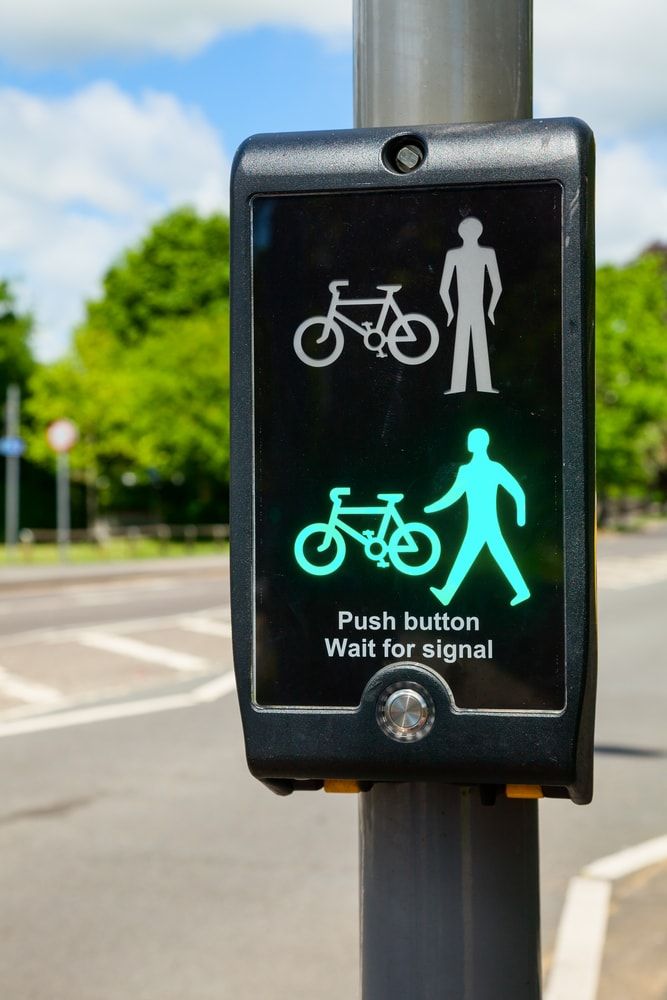
Understanding the legal responsibilities of cyclists and pedestrians is essential for creating safer streets and reducing the risk of accidents. Awareness of these responsibilities can also help clarify liability in case of an accident, protecting all parties involved.
- Cyclists’ responsibilities
- Obey traffic laws: Stop at red lights, signal turns, and ride in the correct direction of traffic.
- Yield to pedestrians: Cyclists must give right-of-way to pedestrians in crosswalks.
- Use safety equipment: Equip bicycles with lights and reflectors, and wear reflective clothing to enhance visibility, especially at night.
- Pedestrians’ responsibilities
- Follow traffic signals: Use crosswalks and adhere to pedestrian traffic lights to avoid jaywalking.
- Avoid sudden movements: Stepping unexpectedly into bike lanes or traffic can increase the risk of accidents.
- Stay alert: Limit distractions like texting, using headphones, or engaging in other activities that reduce situational awareness.
- Shared responsibilities
- Both cyclists and pedestrians must exercise reasonable care to ensure mutual safety.
- Avoid distractions and maintain awareness of the surrounding environment to reduce the likelihood of collisions.
Determining Fault in Cyclist-Pedestrian Accidents: Key Factors
In determining fault for cyclist-pedestrian accidents, several factors are considered:
- Comparative Negligence: This is a common standard used in many jurisdictions to assign a percentage of fault to each party involved in an accident. If the pedestrian and bicyclist contributed to the incident, the fault may be shared proportionally. For example, if a cyclist speeds and a pedestrian crosses the street outside a crosswalk, both parties may be found partially responsible.
- Witness testimony and evidence: Police reports, witness statements, and available footage (such as from surveillance cameras or dashcams) can help clarify how the accident occurred and who was at fault.
- Location of the accident: The location of the accident, such as whether it occurred in a designated crosswalk, bike lane, or another safe area, can help determine fault. Accidents in areas where cyclists and pedestrians are expected to share space may involve shared responsibility.
- Traffic laws: Local traffic laws and ordinances often dictate who has the right of way. Violations of these laws can impact the determination of fault. Generally, the party who violated the law is considered more responsible for the accident.
In cases where fault is disputed, evidence such as witness statements and traffic laws help determine liability. If both parties share fault, understanding comparative negligence and hiring a bicycle accident attorney can be crucial for maximizing compensation.
Legal Responsibilities for Cyclists and Pedestrians Across States
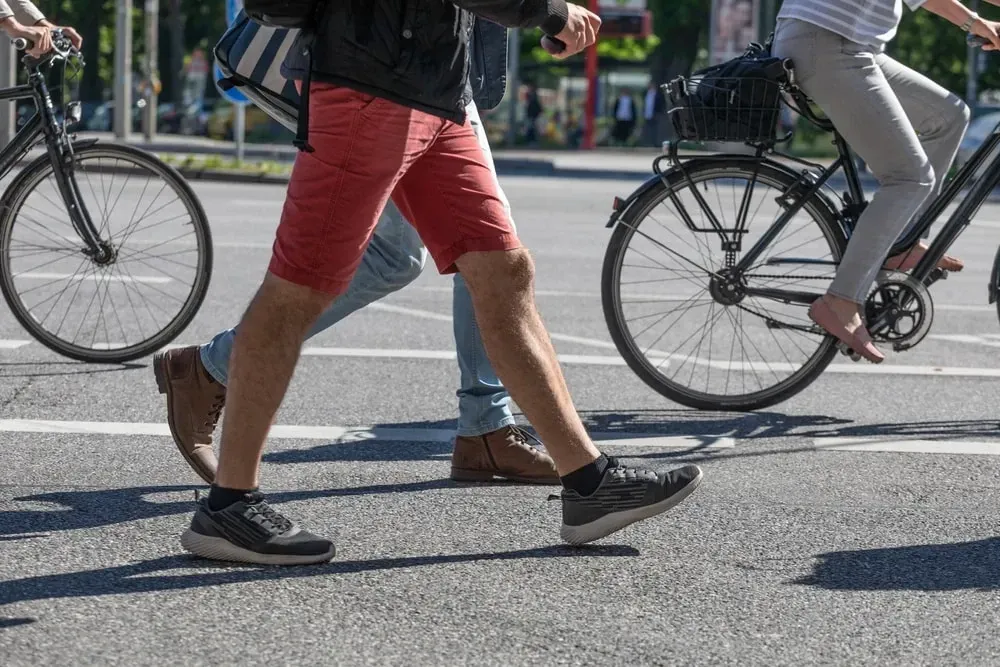
Here are some common laws found in many U.S. states, including California, Texas, New York, Arizona, Utah, Nevada, Oregon, and Idaho, aimed at ensuring safety and clarity for both cyclists and pedestrians:
General laws for cyclists
- Cyclists must yield to pedestrians at crosswalks.
- Cyclists are required to use proper lighting (a white front light and red rear reflector or tail light) when riding at night.
- Audible warnings (e.g., a bell or verbal signal) must be given when overtaking pedestrians.
- Cyclists must obey all traffic laws, including stopping at stop signs and traffic signals.
- Exception: The "Idaho Stop" law allows cyclists in some states to treat stop signs as yield signs and red lights as stop signs. This means a cyclist may slow down and proceed through a stop sign if the intersection is clear, rather than coming to a complete stop. The Idaho Stop law improves cyclist flow and reduces unnecessary stops, but laws vary by state, so cyclists should verify local regulations.
- Cyclists are required to ride in the same direction as traffic.
General laws for pedestrians
- Pedestrians have the right of way at marked and unmarked crosswalks.
- Jaywalking is prohibited; pedestrians must use crosswalks where available.
- Pedestrians cannot walk in bike lanes unless crossing the street.
- Pedestrians must follow traffic signals and avoid crossing against a red light.
- Pedestrians should remain alert and avoid distractions like texting or wearing headphones while walking.
Traffic laws vary by state, but in most cases, cyclists must yield to pedestrians at crosswalks. Learn more about who has the right of way and how cycling laws differ across the U.S.."
Common Causes of Cyclist-Pedestrian Accidents
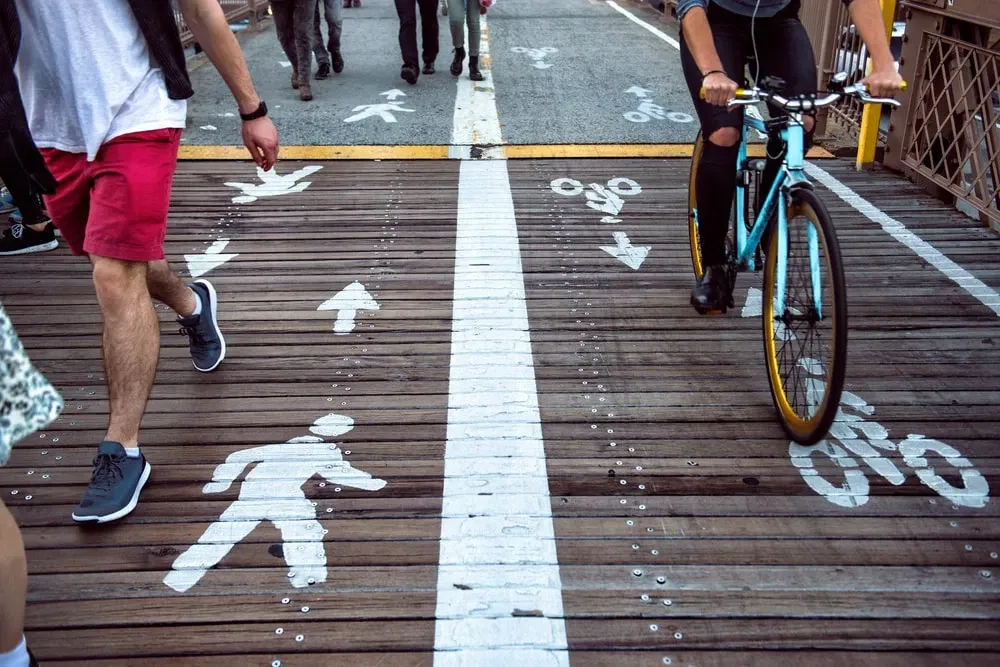
Cyclist-pedestrian accidents can occur due to various factors, some related to human error and others to the infrastructure and environment.
Below are the most common causes of these collisions:
1. Distracted walking and riding
- Pedestrians: People often walk while using mobile devices, listening to music, or talking on the phone, which reduces their awareness of their surroundings. This makes it difficult for pedestrians to notice approaching cyclists, especially in areas where bike lanes or pedestrian paths intersect.
- Cyclists: Similarly, cyclists can be distracted by their own devices or the need to navigate complex traffic situations, leading to misjudgments in speed, timing, or braking.
2. Poor visibility conditions
- Low-light conditions: Cyclists and pedestrians are at greater risk in low-light conditions, such as dusk, night, or foggy weather.
- Inadequate safety equipment: Cyclists who fail to wear reflective clothing or don't use bike lights are at higher risk of collisions. Reflective gear and lights increase visibility, especially in low-light conditions.
- Weather conditions: Heavy rain, snow, or fog can reduce visibility and make it more challenging for cyclists and pedestrians to notice each other in time to react. Wet surfaces can also increase the risk of losing control, leading to falls or collisions.
Cyclists are required to use proper lighting, including a white front light and red rear reflector when riding at night. Choosing the right brightness is essential for visibility and safety—here’s a guide on bicycle light lumens.
3. Infrastructure issues
- Shared spaces: In many cities, pedestrians, and cyclists must share the same path, especially where bike lanes and sidewalks intersect.
- Poorly designed or maintained infrastructure: Faulty or poorly maintained infrastructure, such as uneven pavement, potholes, or debris on bike lanes and sidewalks, can cause cyclists and pedestrians to lose their balance or make sudden evasive movements, leading to accidents.
4. Speed-related factors
- Cyclists’ speed: Cyclists and e-bike riders traveling at high speeds face increased risks of accidents. Excessive speed reduces reaction time, making it difficult to stop or slow down when approaching pedestrians or unexpected obstacles.
- Pedestrians' unpredictable movements: In busy urban areas, pedestrians often fail to assess the speed and distance of oncoming cyclists accurately. This lack of awareness becomes particularly risky when pedestrians step into bike lanes without checking for approaching cyclists or make sudden movements to cross streets or paths
5. Right-of-way confusion
- Unclear or conflicting signals: In some cases, cyclists and pedestrians may assume they simultaneously have the right of way. For example, a pedestrian may step into a crosswalk thinking they are safe, while a cyclist believes they have the right of way through a bike lane or intersection.
- Lack of signage or traffic control: In some locations, unclear or absent signage regarding right-of-way rules can confuse cyclists and pedestrians. When traffic control devices such as signals or stop signs are not marked, cyclists and pedestrians may fail to yield or stop when required.
6. Impaired judgment or substance use
- Cyclists: Cyclists who are impaired by alcohol, drugs, or fatigue may have slower reaction times and poor judgment, making them more likely to collide with pedestrians.
- Pedestrians: Similarly, pedestrians under the influence of alcohol or drugs may cross the street erratically or fail to follow basic safety precautions, such as waiting for the traffic signal or looking both ways before crossing.
7. Failure to yield at crosswalks
- Cyclists failing to yield: Cyclists often fail to yield to pedestrians in crosswalks, especially when traveling at high speeds or in situations without traffic signals. This failure to yield is a significant cause of accidents, particularly in busy urban areas.
- Pedestrians ignoring signals: On the flip side, pedestrians sometimes fail to wait for the appropriate pedestrian signal, cross against the light, or step into bike lanes without checking for oncoming cyclists. Such actions put both parties at risk and complicate efforts to prevent accidents.
Case Study: Notable Pedestrian-Cyclist Collisions
The following real-world examples shed light on the legal and accountability gaps that need to be addressed to ensure safer environments for all road users.
1. Senior Struck by Citi Bike Rider in NYC (2023)
In September 2023, a tragic incident occurred in Manhattan's Chinatown, where 69-year-old preschool teacher Priscilla Loke was fatally struck by an electric Citi Bike rider at the intersection of Grand and Chrystie Streets. The cyclist reportedly ran a red light, leading to the collision. Despite the severity of the incident, the cyclist received only a red-light ticket, sparking public outcry over accountability and the enforcement of traffic laws for e-bike riders.
Implications:
- Accountability: The lenient penalty imposed on the cyclist highlighted potential gaps in the legal framework governing e-bike operations, raising questions about the adequacy of existing laws to address such incidents.
- E-bike safety: The incident underscored the need for stricter regulations and enforcement concerning e-bike usage, especially in densely populated urban areas.
What to Do After a Cyclist-Pedestrian Accident
Establishing Fault
- Importance of evidence: Photos, witness statements, and surveillance footage are critical for determining liability in cyclist-pedestrian accidents.
- Legal standards of liability: Fault may depend on local traffic laws, road conditions, or negligence by either party.
Steps to Take After a Cyclist-Pedestrian Accident
- Seek medical attention immediately: Prioritize your safety by calling 911, even if injuries are not apparent.
- Exchange contact and insurance information: Share details with involved parties and witnesses, including names, phone numbers, and addresses.
- Document the scene: Take photos of the accident site, injuries, property damage, and road conditions. Note time, weather, and any surveillance cameras nearby.
- File a police report: Submit an official statement if the situation requires law enforcement. A police report can be valuable evidence later.
- Consult a bicycle accident attorney: Protect your rights by seeking legal advice, especially if liability is unclear or disputes arise.
If you’re involved in a cyclist-pedestrian accident, taking the right steps immediately can protect your legal rights. Follow this post-accident guide to ensure you gather the right evidence and seek medical attention promptly.
Role of a bicycle accident attorney in cycling accidents with pedestrians
- A bicycle accident attorney can help navigate liability disputes and manage potential insurance claims.
- They provide guidance on evidence collection, legal standards, and negotiating a fair resolution.
Contact a bicycle accident attorney: After addressing immediate concerns, consult with a bicycle accident attorney to protect your rights, especially if the fault is disputed. Legal representation can help ensure a fair resolution.
How Insurance Covers Bicycle Accidents with Pedestrians
When a cycling accident with a pedestrian occurs, determining how damages and medical expenses are covered depends on who is at fault and available insurance policies. Unlike motor vehicle accidents, which are typically covered by auto insurance, cyclist-pedestrian crashes often rely on homeowners, renters, or health insurance policies.
1. Cyclist’s Insurance Coverage
If a cyclist is found at fault for hitting a pedestrian, the following insurance policies may apply:
- Homeowners or Renters Insurance: Many policies include personal liability coverage, which may cover the pedestrian’s medical bills and damages.
- Bicycle Insurance: Some cyclists carry specialized bike insurance, which may provide liability protection and cover property damage.
- Health Insurance: A cyclist’s own health insurance would typically cover their own medical expenses if they are injured in the crash, but not the other party's.
2. Pedestrian’s Insurance Coverage
If a pedestrian is responsible for causing an accident—such as stepping into a bike lane without looking—these insurance options may help:
- Health Insurance: The pedestrian’s health insurance would cover their own medical costs regardless of fault.
- Homeowners or Renters Insurance: If the pedestrian is found at fault for the collision, their personal liability coverage may pay for the cyclist’s medical expenses and property damage.
3. Uninsured/Underinsured Motorist (UM/UIM) Insurance Coverage
UM/UIM insurance only applies to accidents involving motor vehicles. Since bicycles are not classified as motor vehicles, standard UM/UIM coverage does not apply to cyclist-pedestrian accidents.
Since UM/UIM insurance typically excludes bicycle accidents, it’s crucial to read the fine print and know how your policy applies before assuming coverage will apply in a pedestrian-cyclist collision.
Insurance and Compensation for Pedestrian-Cyclist Accidents
Understanding the insurance and compensation types for pedestrian-cyclist accidents is crucial for both parties involved. The Bicyclist's Guide to Insurance covers this in great detail.
Types of Coverage
- Cyclist’s Homeowner's or Renters Insurance Liability Coverage: In many cases, a cyclist's homeowners or renters insurance policy includes personal liability coverage. This can cover damages if the cyclist is found at fault for causing injury to a pedestrian. It's essential to review the specific terms of your policy to understand the extent of coverage.
- Pedestrian’s Health Insurance or Homeowner's, Renters, and Umbrella Policies: Pedestrians injured in accidents typically rely on their health insurance to cover medical expenses. Additionally, if the pedestrian has homeowner's, renter's or potentially an umbrella insurance policy, it may provide liability coverage, offering further financial protection.
Compensation Categories
- Economic damages
- Medical bills: Costs incurred for hospital stays, surgeries, medications, rehabilitation, and any ongoing medical treatments.
- Lost wages: Income lost due to the inability to work during recovery.
- Property damage: Expenses related to repairing or replacing personal property damaged in the accident, such as bicycles or personal items.
- Non-economic damages
- Pain and suffering: Compensation for physical pain endured due to the accident.
- Emotional distress: Compensation for psychological impact, including anxiety, depression, or trauma resulting from the incident.
- Punitive damages: In cases where the at-fault party's behavior was particularly reckless or egregious, punitive damages or exemplary damages might be awarded to punish the wrongdoer and deter similar conduct in the future.
Factors Impacting Compensation
- Apportionment of fault under comparative negligence: Many jurisdictions follow comparative negligence principles, where compensation is adjusted based on each party's degree of fault. For instance, if a pedestrian is found to be 30% at fault and the cyclist 70%, the pedestrian's compensation would be reduced by their 30% share of fault.
- Severity of injuries and long-term impacts: The more severe and long-lasting the injuries, the higher the potential compensation. Factors include the extent of medical treatment required, permanent disabilities, and the impact on the individual's quality of life.
Proper documentation of the accident, including medical records and police reports, is necessary in all cases to successfully file an insurance claim. If a collision occurs in cities such as Los Angeles, the police may not file a police report leaving victims to obtain evidence on their own.
Prevention Strategies to Avoid Cyclist-Pedestrian Accidents
Infrastructure improvements, safety measures for cyclists and pedestrians, and community education can often prevent cycling accidents involving pedestrians.
Some effective prevention strategies are:
1. Infrastructure solutions
Improving pedestrian and bicycle infrastructure can significantly reduce accidents between cyclists and pedestrians:
- Dedicated bike lanes: One of the most effective ways to separate cyclists from pedestrians is to create protected bike lanes. These lanes keep cyclists off sidewalks and out of pedestrian spaces, significantly reducing the risk of accidents.
- Clear crosswalks and bike lane intersections: Properly designed intersections where bike lanes and pedestrian crosswalks meet can prevent accidents. Clear signage and traffic control signals (e.g., traffic lights, pedestrian signals) should be installed to indicate who has the right of way at these crossings.
- Improved lighting: Adequate street lighting is crucial for visibility, especially in the evening or nighttime. Cities should invest in lighting that covers roads, bike lanes, pedestrian walkways, and crosswalks.
- Pedestrian safety zones: Implementing pedestrian-only zones or buffer zones where cyclists cannot ride can reduce conflict in areas with high foot traffic. These zones could be particularly effective in busy city centers, parks, or near schools.
- Expansion of urban networks: Expanding cycling and pedestrian infrastructure, like New York City’s 1,200 miles of bike lanes, ensures better connectivity and reduces crowding on shared pathways. This also encourages safer commuting options.
- Traffic calming measures: In areas with heavy pedestrian activity, installing speed bumps, raised crosswalks, and traffic circles can slow down cyclists and vehicles, improving pedestrian safety.
2. Safety equipment
Both cyclists and pedestrians can reduce the risk of accidents and injuries by utilizing safety equipment:
- Helmets for cyclists: While laws regarding bicycle helmet use vary, wearing a properly fitting helmet is one of the best ways cyclists can protect themselves in the event of a collision, particularly head injuries, which are among the most severe types of trauma in accidents.
- High-visibility clothing: Cyclists should wear bright, reflective gear to ensure they are visible to pedestrians, especially at night or during low-light conditions.
3. Technology aids
As technology continues to evolve, new innovations are making it easier for cyclists and pedestrians to stay safe on the streets. Some of the most effective technological aids designed to prevent cyclist-pedestrian accidents are:
| Technology Aid | Purpose | Benefits |
|---|---|---|
| Bells or Horns | Alert pedestrians to cyclist presence | Enhances awareness and prevents unexpected encounters |
| Lights for Cyclists | Increase visibility during low-light conditions | Reduces collision risk, especially at night |
| Wearable Technology | Provide real-time alerts and signals to cyclists | Improves hazard detection and response times |
| Bicycle Cameras | Record interactions and incidents between cyclists and pedestrians | Offers evidence for resolving disputes and improving accountability |
| Smart Crosswalks | Coordinate crossing signals based on real-time detection of pedestrians and cyclists | Enhances safety by managing pedestrian and cyclist flow efficiently |
Advancements in cycling safety technology, such as smart lights, wearable sensors, and bike cameras, help reduce accidents and improve visibility. Explore the best bicycle safety accessories to enhance your protection on the road.
Safer Streets Start with You: How to Avoid Pedestrian-Cyclist Crashes
Understanding the common causes of cyclist-pedestrian accidents is the first step toward improving road safety for everyone. By staying aware of these risks and adopting safer practices, cyclists, and pedestrians can work together to prevent accidents and enjoy safer travels.
Key Takeaways:
- Stay alert and avoid distractions when walking or cycling.
- Use designated bike lanes and crosswalks to reduce risk.
- Always prioritize visibility with reflective gear and lights, especially in low light.
- Respect right-of-way rules to prevent confusion and accidents.
- Wear proper safety equipment, such as helmets and reflective clothing.
FAQs on Cycling Accidents with Pedestrians
Q: Who is at fault in a cycling accident with a pedestrian?
A: Fault depends on the circumstances. Cyclists must follow traffic laws and yield to pedestrians, while pedestrians must obey signals and avoid stepping into traffic unexpectedly. In many cases, fault is shared, with liability determined by comparative negligence laws.
Q: What should I do if I’m involved in a cycling accident with a pedestrian?
A: Seek medical help, document the scene, exchange information, and file a police report. Consult a bicycle accident attorney to understand your legal options.
Q: What happens if a cyclist hits a pedestrian?
A: If a cyclist hits a pedestrian, both parties should seek medical attention, document the accident, and file a police report. Liability depends on the circumstances—if the cyclist was negligent, they may be responsible for damages, while pedestrians who acted recklessly may share fault. Insurance or legal action may be needed to cover injuries and expenses.
Ride Protected, Ride Safe with Bike Legal
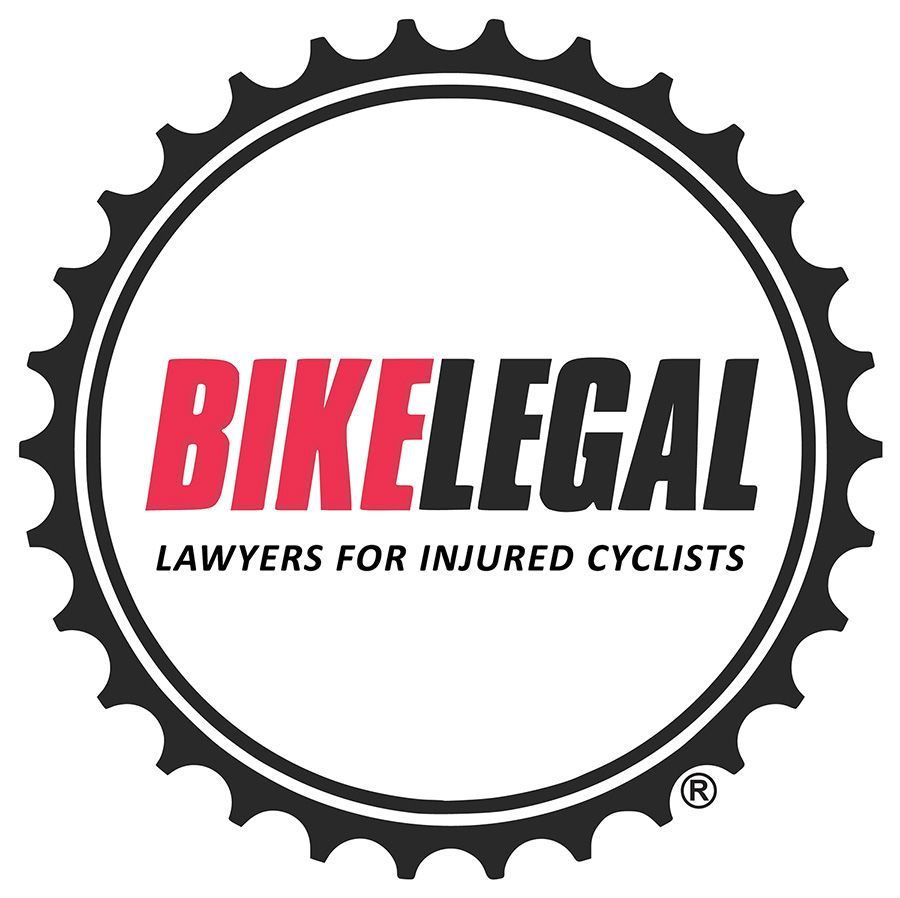
If you've been involved in a cyclist-pedestrian accident, securing legal help is crucial. Whether you’re a cyclist facing liability concerns or a pedestrian seeking compensation, our team at Bike Legal has the experience to fight for your rights.
📞
Call us now at 877-BIKELEGAL (877-245-3534) for a FREE consultation.
✅ Get expert legal guidance tailored to bicycle accident cases.
✅ Maximize your compensation and protect your legal rights.
✅ Work with attorneys who truly understand cyclists.
👉 Contact Bike Legal Now for expert representation.
